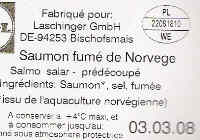
Fishy Falsehoods
I need to supplement my body's vitamin D levels. I prefer to do this with food, rather than pills. Cold water fish are a great source of vitamin D and eating smoked salmon is a pleasure for me; so, once each week, I have been buying a package of salmon. It is packaged nicely, looks good, tastes great and is reasonably priced.  I always read the labels and in this case it states the contents as salmon, salt and smoke. How have I been deceived?
I always read the labels and in this case it states the contents as salmon, salt and smoke. How have I been deceived?
While doing some research for a human rights organization, (the right to food is a fundamental human right, in most of the world but not in the United States) I stumbled across some disturbing information. Have you ever heard of, or seen a Salmofan?  It is like a color wheel or set of paint chips. It allows the salmon farmer to add the right amount of colorant to get the desired pinkness in the finished salmon. The food wholesalers tell the salmon farmer what color to produce and the salmon are raised for that color. As you can see from the label, no colorants have been added.
It is like a color wheel or set of paint chips. It allows the salmon farmer to add the right amount of colorant to get the desired pinkness in the finished salmon. The food wholesalers tell the salmon farmer what color to produce and the salmon are raised for that color. As you can see from the label, no colorants have been added.
Wild salmon, as everyone knows, are orangish pink on the inside. What most people do not know, however, is that salmon are pink because of what they eat. Salmon are carnivorous fish that dine on krill, tiny shrimp-like crustaceans that contain carotenoids, naturally-occurring orange pigments.
Farm-raised salmon, on the other hand, eat feed that is made of other fish. Consequently, unless color is added to their food, farmed salmon do not turn out orange, but rather a less appetizing light grayish color. Studies have shown that consumers are willing to pay more for darker-colored salmon. Thus, although adding color to salmon feed is expensive, salmon farmers find it worthwhile.
The artificial colorant added to fish feed, cantaxanthin, has been linked to retinal damage, when taken orally to simulate a suntan color in people's skin. This got me looking deeper into the uses of cantaxanthin. Among other uses it is fed to chickens, so the yolks of the eggs are a color to match the egg yolks of free range chickens. It is also added to broiler chickens, so that their skin has a 'healthy' slightly yellow, more appealing look. The range of colors are determined by regional market preferences.
The French revolutionary philosopher was correct, when he stated in "Candide", that "...in the end, the only thing that makes sense is to stay home and grow your own food."
Caveat emptor! - Buyer beware!